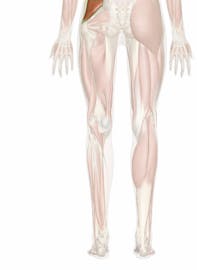The Gluteus Medius
Explore Innerbody's 3D anatomical model of the gluteus medius, a major muscle in the gluteal region.

The gluteus medius muscle is one of the major muscles of the body's gluteal, or buttock, region. It plays a key role in the function of the lower limb by abducting and medially rotating the thigh at the hip joint. The gluteus medius lies deep in the larger and better-known gluteus maximus muscle.
Anatomy
The gluteus medius muscle is a teardrop-shaped muscle located in the posterior hip. It is located deep and lateral to the gluteus maximus muscle and superficial to the gluteus minimus. The gluteus medius arises from a broad origin on the posterior surface of the ilium inferior to the iliac crest. From its origins, its muscular fibers extend laterally and inferiorly across the posterior side of the hip joint. As the fibers extend, they converge and form a narrow tendon that inserts on the greater trochanter of the femur.
Physiology
Contraction of the gluteus medius pulls its insertion on the femur closer to its origins on the posterior ilium. Depending on the actions of the other hip muscles, this contraction may result in either abduction or rotation of the hip. Acting alone, the gluteus medius abducts the hip, pulling the femur laterally and away from the other leg. Hip abduction is commonly used when spreading the legs apart to change direction while running, walking, or widening one’s standing position for increased stability. When the gluteus medius contracts at the same time as the adductor muscles of the groin, it results in rotation of the hip. Medial rotation produced by the anterior fibers turns the thigh toward the body’s midline so that the knee moves closer to the opposite knee. A common daily application of medial rotation occurs when changing from a sitting or standing position with the legs and feet slightly apart and beginning to walk with the legs close together and feet facing forward.


